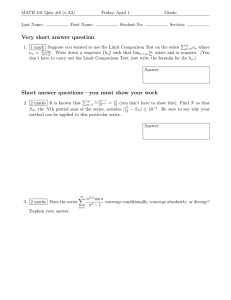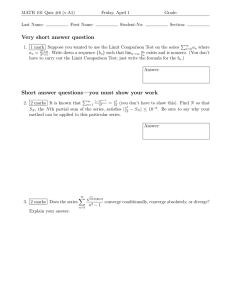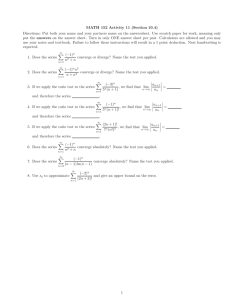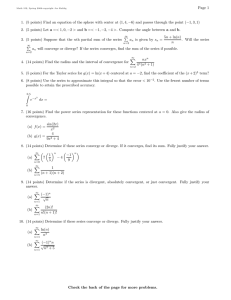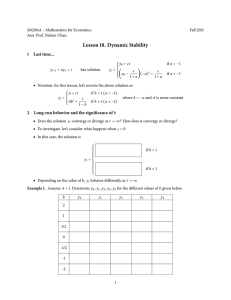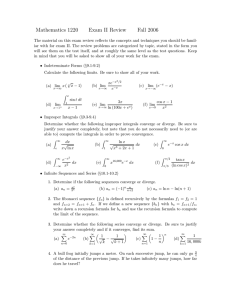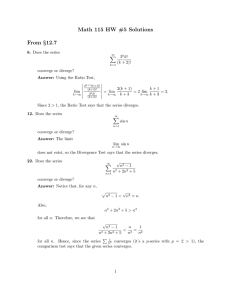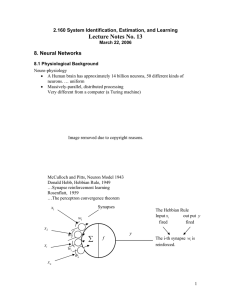S01
advertisement
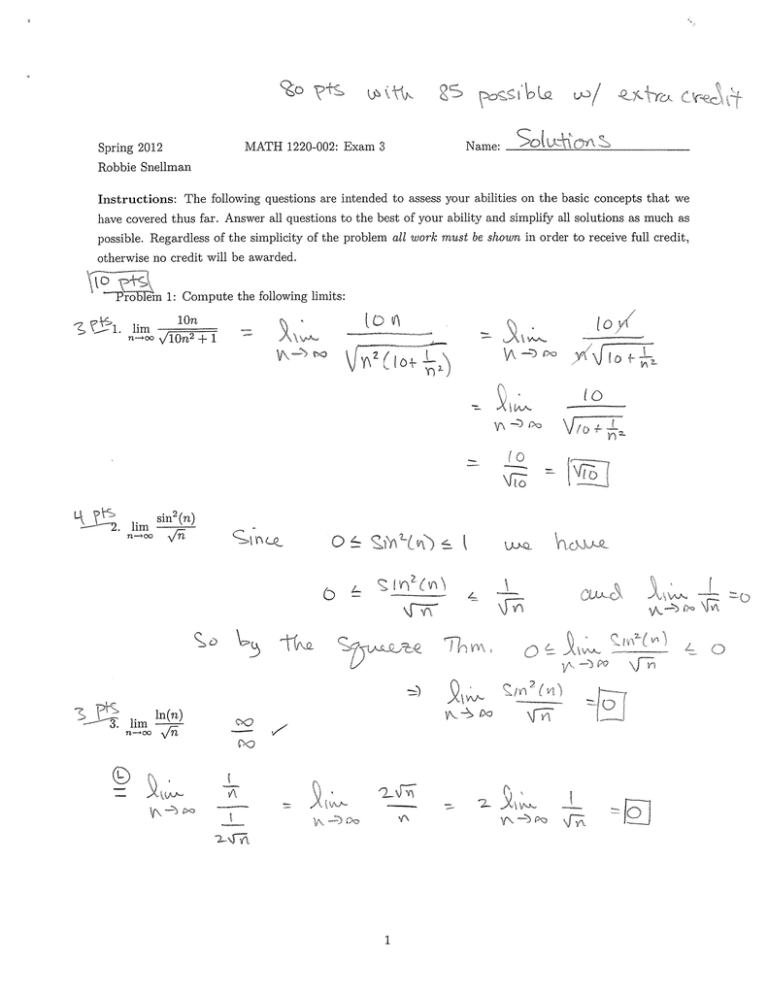
~o ?t:~ ~(‘r1j~ I Name: MATH 1220-002: Exam 3 Spring 2012 ~2 ~ S01 J~(,i’ ~ Robbie Sneliman Instructions: The following questions are intended to assess your abilities on the basic concepts that we have covered thus far. Answer all questions to the best of your ability and simplify all solutions as much as possible. Regardless of the simplicity of the problem all work must be shown in order to receive full credit, otherwise no credit will be awarded. 15l~m 1: Compute the following limits: lim (0 iOn ./10n2 + 1 (0 — 0 —~ ‘C— ~to 2. lim — ~l0 sin2(n) n—~oo C ~ ~i~L~) ~ i CW~ ~‘1 ~) ~° 7 pi~c 5~J~ c~’ ln(n lim — n—Do -C>, 1 ~—~1 2: Does t1~e series ~ n=1 n + ~ converge or diverge? Why or why not? n3 + 1 ‘A = L -~ c~v ‘A~~—~) ~ ~Po~1~Y~ ~?c~ ~1 I S 2 Thwi~ ~o ?isI ~~—~P~’b1bm 3: Find the radius and interval of convergence of the following power series: n=O u~cc Q ~ 3~(x+1)~ n! k~~ 3 I ~ ___ Radius of Convergence: J~b _______ Interval of Convergence: 3 (. 0—’. ~ cr~ ~ ,~) -c4—ç~ 00 3 ~ n3 Problem 4: Does the series ~ ~ + 1)! converge or diverge? Why or why not? V-~c~ô ~TR~c~; - r\~ ~ ( ~ ~ 3V~ (v~+-~~ ~ ~ ~ ~3/J (~i) i~ ~ n~ N ~ 3 ~ ~~ ~ d~o~~Q \~%&jc~.*.. ~ c~ \3 ‘3 )‘~ —:r——; ~° 3 so Q~v~3 4 t~ 1 Problem 5: Is tne series ~ 1)1~n3 2r’ _ n=1 absolutely convergent, conditionally convergent, or divergent? Why or why not? u~ ~~ ~ I ~ ~çc~ ~9 ~ j~\j ~ — C~-~A 7y 2 (V Lj;~ ‘C C. T~Q 0 2: 5 ~ Problem 6: Find the first four terms of the Taylor series for eX based at the point a ~ ~ = 2. f ç 1’ /~(N~ 2 ~ jlAiJ(~ ~(~N r - ~ ~ ~ ( ~ ~ ~j~( +1v~C~% ~ ~ ~ ~ ~ ~tV~ c~ ~c~\A~LK- ~ ~ ~cs~cr~ic~ ~k~Ct2 6 ~r ~ +~rwLc, 1 roblem 7: Find the power series representation for the function (1 + x)3 for z in the interval (—1, 1). ~ (_)ç~A= ~•\t~c) L ( ~ i \ (a+~y~) — ~ -?-~-~- ~ ~ ~‘ ~ ~ ~ L__. C’’ 1~ / ~+r / ~ A __ 2- ~ ‘~‘~-~ ~ ~2~) I ~ I ~ ( —J 7 I Problem 8: Does t he series ~ W~ n —~- converge or diverge? Why or why iiot? O\~ ~ J ~ k~ ) — ) J:) — - V So ~ (3 ~ 8 3 Extra Credit~j1 Show that the Taylor series, based at the point a = 0, of the polynomial f(x) x3 + bx~ + cx + d~x), where b, c, d are real numbers. ~ ~ ~ ~ ~ +°~4~c~ C ~ (y~N~ g~ oI~~ ~- / I I \> / ~> 42 ) — J ~oN4 ~ 2-’ ~- — 2 (~y~ ~ ~\SL 9 ~ Important Maclaurin series: ~~i+z+x2+x3+... —1<x<1 1—x 1n(l+x)=X—~+~~+. —l<z≤l —l<x~l e~ =1+ x + x2 + + x3 x5 z2 ~ x3 x5 ~r2 x4 + x7 x6 10

